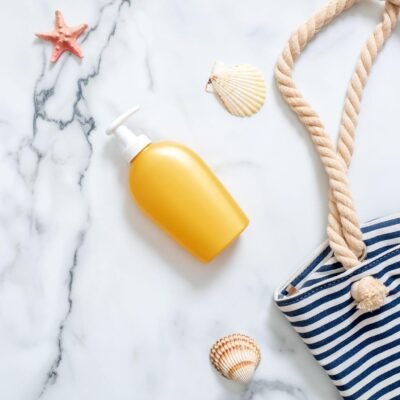Learn how to make your own mineral sunscreen at home with this easy DIY recipe. Made with all-natural ingredients, this homemade sunscreen provides effective protection against the sun’s harmful rays without any harsh chemicals. Follow our step-by-step guide to create your own natural sunscreen that is perfect for the whole family.

DIY Mineral Sunscreen Recipe
Equipment
- Small mixing bowl
- Whisk or fork
- Measuring spoons and cups
- Container for storing the sunscreen (such as a small jar or bottle with a lid)
Ingredients
- 2 tbsp zinc oxide powder
- 2 tbsp shea butter
- ¼ cup coconut oil
- ¼ cup almond oil
- ¼ cup beeswax
- 15-20 drops essential oil (optional, for scent)
Instructions
- In a small mixing bowl, combine the zinc oxide powder, coconut oil, shea butter, almond oil, and beeswax.
- If using essential oil, add it to the mixture.
- Using a whisk or fork, mix the ingredients together until they are well combined and the mixture has a smooth consistency.
- Transfer the sunscreen to a container for storage.
Notes
- The SPF of this sunscreen will depend on the amount of zinc oxide used. Using the amounts listed above will result in an SPF of approximately 20-30.
- If you want a higher SPF, you can increase the amount of zinc oxide. However, keep in mind that zinc oxide can leave a white residue on the skin, so it's best not to use too much.
- This sunscreen is best for use on the face and body, but it may not be suitable for use on the lips.
How to Use:
- Before going outside, apply the sunscreen to exposed skin, using a circular motion to rub it in.
- Reapply the sunscreen every 2 hours, or immediately after swimming or sweating.
- To remove the sunscreen, use a gentle cleanser or makeup remover.
Is mineral sunscreen Really Better?
There is debate over whether mineral sunscreen is really better than chemical sunscreen. Some people argue that mineral sunscreens, which contain physical blockers like zinc oxide and titanium dioxide, are more natural and less irritating to the skin. However, others argue that chemical sunscreens, which contain ingredients like avobenzone and oxybenzone, are more effective at protecting against UV rays.
Do dermatologists recommend mineral or chemical sunscreen?
Many dermatologists recommend using mineral sunscreen, especially for people with sensitive skin or allergies to certain chemical ingredients. However, some dermatologists may recommend chemical sunscreens for certain situations, such as when higher levels of protection are needed.
How often should you reapply mineral sunscreen?
Mineral sunscreen should be reapplied every two hours or immediately after swimming or sweating.
Does mineral sunscreen dry out skin?
Mineral sunscreen may have a drying effect on some people’s skin, especially if it is not properly moisturized beforehand. However, there are also mineral sunscreens that are formulated to be more hydrating.
Can you use mineral sunscreen everyday?
It is generally safe to use mineral sunscreen every day, as long as it is applied in the recommended amount and is not causing any irritation or adverse reactions.
Does mineral sunscreen age your skin?
There is no evidence to suggest that mineral sunscreen ages the skin. In fact, using sunscreen regularly can help to prevent premature aging caused by UV damage.
Do mineral sunscreens leave a white cast?
Some mineral sunscreens may leave a white cast on the skin, especially if they are not properly blended in. However, there are also mineral sunscreens available that are formulated to be more transparent or have a lighter color.


